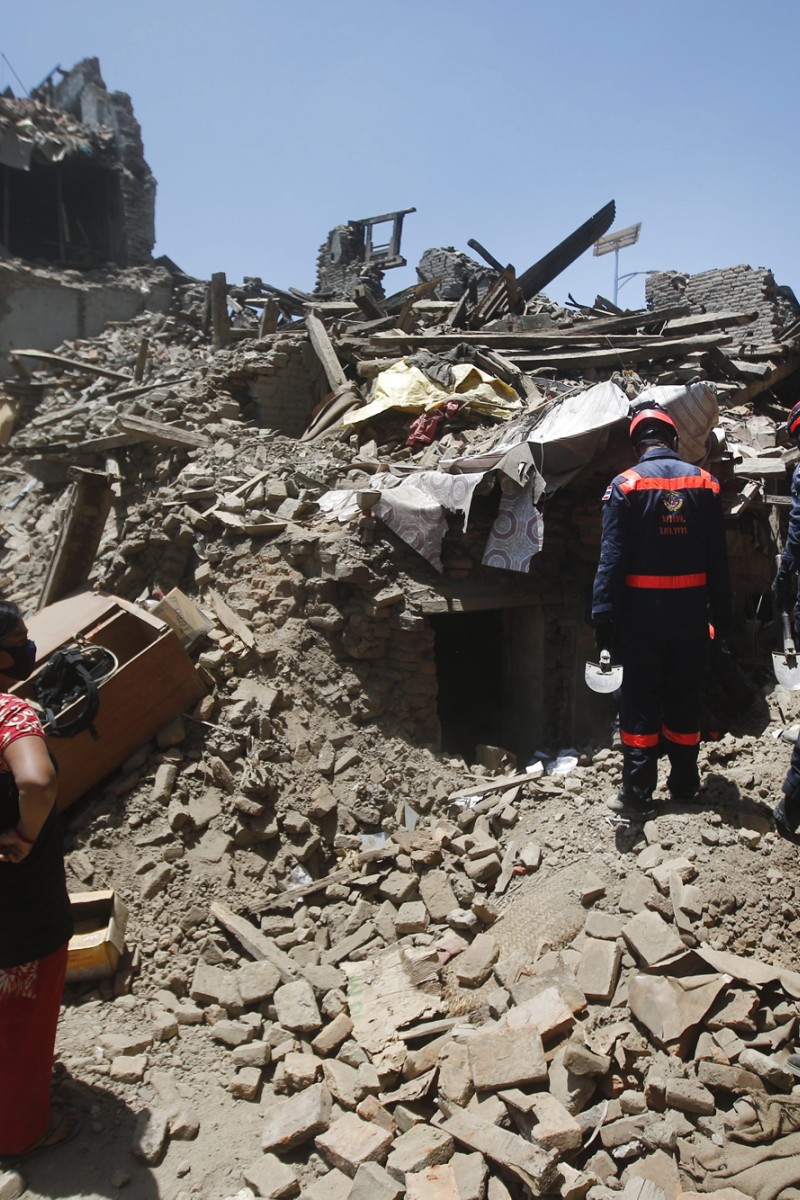
Though some time has passed since the devastating earthquake in Nepal, there are still many problems and fears left behind. Here is what you can do
 Local women looks on as a search and rescue team from the Royal Thai Armed Forces together with members of the Nepalese army dig at the entrance to where a home used to stand in search for the owner's body in Sankhu.
Local women looks on as a search and rescue team from the Royal Thai Armed Forces together with members of the Nepalese army dig at the entrance to where a home used to stand in search for the owner's body in Sankhu.Runway damage has forced Nepalese authorities to close the main airport on Sunday to large aircraft delivering aid to millions of people following the massive earthquake.
It was built to handle only medium-size jetliners, not the large military and cargo planes that have been flying in with aid, supplies, food, medicines, and rescue and humanitarian workers.
“You’ve got one runway, limited handling facilities, and the ongoing commercial flights,” said Jamie McGoldrick, the United Nations coordinator for Nepal. “You put on top of that massive relief items coming in, the search and rescue teams that have clogged up this airport. Once they put better systems in place, that will get better.”
Problems like this one, and others, are what's leaving Hong Kong students, like 14-year-old Bakhita Fung of Island School, wondering how we can help.
“The situation in Nepal is truly heartbreaking and terrifying. We are praying for those affected. However, I am curious to know how we (as students) can help - will money be put in the right hands? Will supplies (e.g blankets, food or clothes) actually be accessible to victims?”
At the moment, it seems that may be a challenge.
People in Nepal – both in remote villages and the capital, Kathmandu – have complained about not seeing any rescue workers or international aid, and about a lack of temporary shelters. Many are sleeping out in the open because of fears of aftershocks bringing down their damaged homes.
On top of that, UN officials said they were increasingly worried about the spread of disease. They said more helicopters were needed to reach isolated mountain villages that were hard to access even before the quake.
One major concern when dealing with diseases is the lack of clean water.
“The Nepal earthquake is undoubtedly a tragedy and has revealed the underestimated seriousness of the lack of clean water," said Shirley Tsang, a 20-year-old student at the University of Toronto. "This would have greatly hindered the process of performing on-site surgeries right after the earthquake, and volunteer doctors have to use bottled water instead. A water filtering and cleaning system is urgently needed.”
The death toll now is 7,276, including six foreigners and 45 Nepalese found over the weekend. Nepal’s Tourist Police reported that a total of 57 foreigners were killed in the April 25 quake, and 109 are still missing.
Most of the victims were Nepalese guides, hotel owners, workers and porters. The area, with a dozen inns near the trekking trail, was buried by a landslide after the earthquake.
Nepal has been hit by more than 70 aftershocks following the quake, and its people remain on edge, especially in the district of Sindupalchok, where more deaths have been recorded than anywhere else in Nepal: 2,560, compared to 1,622 in Kathmandu. The UN says up to 90 per cent of the houses in Sindupalchok have been destroyed.
The extent of the damage from the earthquake is still unknown as reports keep filtering in from remote areas, some of which remain entirely cut off. The UN says the quake affected 8.1 million people – more than a quarter of Nepal’s 28 million people.
When it comes to preventing such tragedies in the future, there is one clear answer for Kathmandu – better urban planning. , says that Nepal has not had deadly earthquakes for more than 80 years despite being at the edge of the Eurasian and Indian tectonic plates.
“Nepal is a beautiful yet poor country, which lacks capital and skills to lay down strong and solid urban planning that can withstand mega earthquakes," said Laxmi Limbu, an 18-year-old Nepalese student at the University of Hong Kong. "I am grateful for the help the international community is giving but I do feel Nepal has a greater need for professionals in the long-run who can help with city rebuilding to prevent such tragedies from reoccurring. Nevertheless, I feel proud and happy at the concern Hong Kong people are showing towards this disaster.”
What you should know:
What you should keep in mind:
There are so many organizations doing disaster relief that it can be difficult knowing which one to donate your money and time to. NPR has a quick guide to help you make a smart and effective donation. The key points are:
- What is the charity doing?
- Does it know its way around Nepal?
- What is the money being spent on?
- Be sure not to donate used clothes or physical items unless you know those will be helpful. Check out the full guide here.
Importance of water:
A blog post from UNICEF in the UK points out that when homes are destroyed in disasters like earthquakes, people often don’t have toilets. If the water supply gets contaminated, diseases like diarrhoea and cholera can spread easily. Nepal has regular seasonal outbreaks of cholera, so there’s a risk of seeing a similar kind of outbreak to the one in Haiti after the earthquake in 2010, where thousands were killed.
Prevention over treatment:
The Atlantic’s Citylab blog says unplanned development around Kathmandu made the situation worse once the earthquake hit. It refers to a 2013 World Bank report, saying that the city has been growing very quickly, but the buildings weren’t properly planned and some didn’t even follow safety codes that would have protected people in an earthquake.